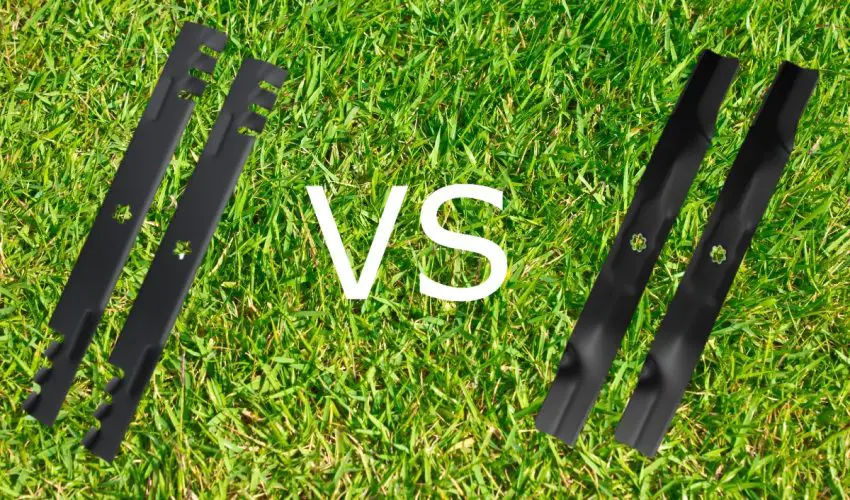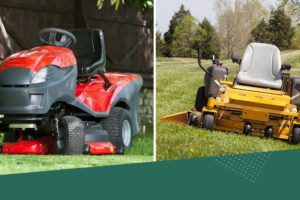Understanding the differences between these blades can help you select the best option for your specific needs and preferences.
Mulching blades cut grass into fine pieces that can be left on the lawn as natural fertilizer, while regular blades cut grass in a one-swipe motion, discharging clippings onto the lawn or into a bag.
Mulching blades typically have a more curved design, whereas regular blades are straighter and more aerodynamic.
Table of Contents
ToggleWhat are Mulching Blades?
Mulching blades are specially designed lawn mower blades that cut grass into fine pieces, allowing them to be mulched back into the lawn. They often feature a curved design with extra cutting surfaces, promoting natural fertilization and water conservation by returning the grass clippings as nutrients to the soil.
Benefits of Mulching Blades
Mulching blades offer a unique approach to lawn care, providing both cutting efficiency and eco-friendly benefits. Here’s some of the benefits of using mulching blades.
- Environmentally Friendly: Mulching blades cut grass into fine pieces that decompose quickly, returning valuable nutrients to the soil. This natural recycling process enhances the soil’s fertility and reduces the need for artificial fertilizers.
- Aesthetically Pleasing: By finely cutting the grass clippings, mulching blades allow them to blend into the lawn, maintaining a clean and neat appearance.
- Water Conservation: The mulch created by these blades helps retain soil moisture, reducing the need for frequent watering.
- 3-in-1 Functionality: Often referred to as “3-in-1” blades, mulching blades can mulch, bag, or side-discharge grass clippings, offering versatility in lawn maintenance.
- Natural Weed Control: The mulch layer can suppress weed growth by blocking sunlight from reaching weed seeds.
Drawbacks of Mulching Blades
While mulching blades offer specific advantages, they also come with some limitations that might affect their suitability for certain tasks. Here’s an exploration of the potential drawbacks of using mulching blades.
- Not Suitable for Overgrown Grass: Mulching blades may become clogged or less effective when used on tall or wet grass, leading to uneven cuts or lumps of grass on the lawn.
- Potential Pest Issues: The mulch created can sometimes provide a suitable environment for certain bugs and pests to thrive, though it does not attract them.
- Power Requirements: Depending on the mower’s design, mulching may require a more powerful engine to perform efficiently.
What are Regular Blades?
Regular blades, also known as standard or 2-in-1 blades are typically used in lawn mowers to cut grass in a straight and clean manner. Unlike mulching blades they are designed to either discharge the grass clippings onto the lawn or collect them into a bag for disposal.
Benefits of Regular Blades
Here’s some of the benefits of using regular blades on lawn mowers, offering a cost-effective and efficient solution for maintaining a healthy lawn.
- Efficiency: Regular blades are highly efficient for cutting tall and dense grass, making them suitable for lawns that are mowed less frequently.
- Clean Appearance: By bagging or discharging the grass clippings, regular blades can provide a clean and well-manicured look to the lawn.
- Versatility: They can be easily used for different lawn types and conditions, including wet grass, without the risk of clogging.
Drawbacks of Regular Blades
Regular blades on lawn mowers certainly have their benefits but they can also come with some challenges that might affect how suitable they are for different tasks.
- Waste Generation: Since the grass clippings are often bagged and thrown away, this can lead to more waste in comparison to mulching.
- Lack of Natural Fertilization: Unlike mulching blades that return nutrients to the soil, regular blades remove the clippings, potentially losing valuable nutrients.
- Potential Higher Energy Consumption: Some regular blades might require more energy or fuel to operate, especially if used to bag the clippings.
Differences between Mulching Blades and Regular Blades
Understanding the differences between mulching blades and regular blades is essential for choosing the right option for your lawn care needs. Below, you’ll find a comparison table highlighting the key difference between these two types of mower blades:
| Metric | Mulching Blades | Regular Blades |
|---|---|---|
| Functionality | Cut, mulch, and discharge grass clippings in one go | Cut and discharge grass clippings |
| Design | Curved surface with extra cutting edges | Straight and aerodynamic design |
| Efficiency on Tall Grass | Less efficient on tall or overgrown grass | Efficient on tall grass |
| Environmental Impact | Eco-friendly, returns nutrients to soil | May generate more waste and use more energy |
| Appearance of Lawn | Leaves fine clippings as natural fertilizer | Provides a clean, neat appearance without clippings |
| Compatibility | May fit most mowers but needs to match the deck | Usually easily replaceable and fits various mowers |
| Use on Wet Grass | Risk of clogging under the deck | Can handle wet grass without much clogging |
Which is Better: Mulching Blade or Regular Blade?
Mulching blades are better for environmental benefits and natural fertilization, cutting grass into fine pieces that decompose quickly. Regular blades provide a clean and well-manicured appearance, efficiently cutting tall grass. Consider factors like mowing frequency, grass type and desired lawn appearance to determine the better option for your particular situation.
Can you replace a regular blade with a mulching blade?
Yes, you can often replace a regular blade with a mulching blade provided the replacement is compatible with your mower’s specifications. It’s important to check the length, width and mounting configuration to ensure proper fit. Keep in mind that using a mulching blade on a mower not designed for mulching might not produce optimal results.
The Verdict
The choice between mulching blades and regular blades depends on your lawn’s specific needs and your mowing preferences.
Use Mulching Blades If:
- You mow frequently, such as every 3-4 days.
- You want to naturally fertilize your lawn by leaving finely cut grass clippings as mulch.
- You prefer an environmentally friendly approach.
Note: Avoid using on overgrown or wet grass, as it may cause clogging.
Use Regular Blades If:
- You mow less frequently, such as once a week or every 10 days.
- You prefer a clean and neat appearance, with larger clippings either bagged or dispersed evenly on the lawn.
- You’re cutting tall grass, as regular blades are more efficient in these conditions.
By considering these factors and understanding the characteristics of your lawn, you can make the most informed choice between mulching and regular blades, ensuring that you achieve the desired results in your lawn care routine.





